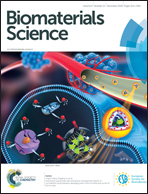Transient binding promotes molecule penetration into mucin hydrogels by enhancing molecular partitioning†
Abstract
Here, we present a microfluidics chip platform which allows for studying the charge-dependent transport of molecules across the interface of acidic mucin gels. With this setup, we demonstrate a selective accumulation of molecules at the liquid/gel interface of mucin hydrogels that occurs as a function of the molecule charge: this phenomenon is strongly pronounced for cationic molecules, weakly pronounced for anionic molecules and absent for neutral molecules. We suggest that molecular transport into and across the gel depends on two main factors, i.e. molecule partitioning from the liquid phase into the gel phase and molecule diffusion throughout the gel. Transient binding of charged molecules to the mucin biopolymers enhances the former process whereas it slows down the latter. This model is supported by a theoretical description of this molecular transport process that is based on diffusion-reaction equations. With this model, we predict the efficiency of the diffusive transport of charged objects across self-renewing physiological mucus barriers. Our results challenge the prevailing notion that inert, non-mucoadhesive molecules were always more efficient in penetrating mucin-based hydrogels such as native mucus than charged molecules.



 Please wait while we load your content...
Please wait while we load your content...